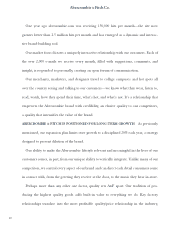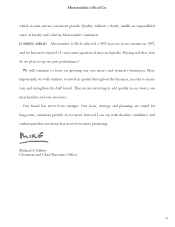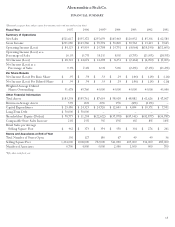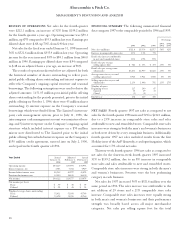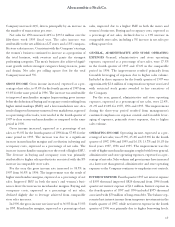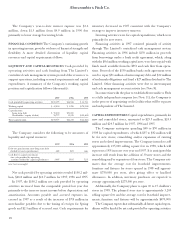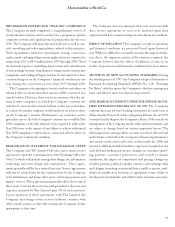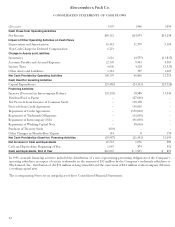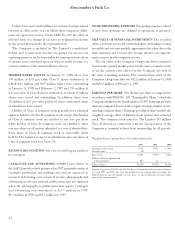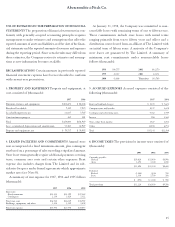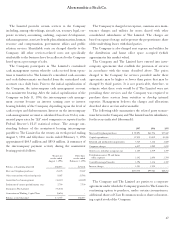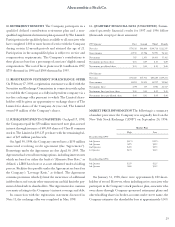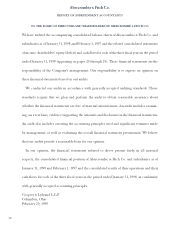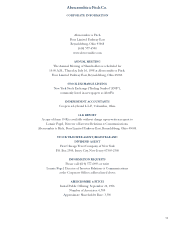Abercrombie & Fitch 1997 Annual Report Download - page 15
Download and view the complete annual report
Please find page 15 of the 1997 Abercrombie & Fitch annual report below. You can navigate through the pages in the report by either clicking on the pages listed below, or by using the keyword search tool below to find specific information within the annual report.
23
Abercrombie &Fitch Co.
1. BASIS OF PRESENTATION Abercrombie & Fitch Co. (the
“Company”) was incorporated on June 26, 1996, and on July 15,
1996 acquired the stock of Abercrombie & Fitch Holdings, the par-
ent company of the Abercrombie & Fitch business, and A&F
Trademark, Inc., in exchange for 43 million shares of Class B
common stock issued to The Limited, Inc. (“The Limited”).
The Company is a specialty retailer of high quality, casual apparel
for men and women with an active, youthful lifestyle. The busi-
ness was established in 1892 and subsequently acquired by
The Limited in 1988.
An initial public offering (the “Offering”) of 8.05 million
shares of the Company’s Class A common stock, including the
sale of 1.05 million shares pursuant to the exercise by the under-
writers of their options to purchase additional shares, was
consummated on October 1, 1996. As a result of the Offering,
84.2% of the outstanding common stock of the Company is
owned by The Limited.
The net proceeds received by the Company from the
Offering, approximating $118.2 million, and cash from opera-
tions were used to repay the borrowings under a $150 million
credit agreement.
The accompanying consolidated financial statements include
the historical financial statements of, and transactions applicable
to the Company and its subsidiaries and reflect the assets, liabil-
ities, results of operations and cash flows on a historical cost basis.
2. SUMMARY OF SIGNIFICANT ACCOUNTING POLICIES
PRINCIPLES OF CONSOLIDATION The consolidated finan-
cial statements include the accounts of the Company and all
significant subsidiaries that are more than 50% owned and con-
trolled. All significant intercompany balances and transactions
have been eliminated in consolidation.
FISCAL YEAR The Company’s fiscal year ends on the Saturday
closest to January 31. Fiscal years are designated in the financial
statements and notes by the calendar year in which the fiscal
year commences. The results for fiscal years 1997 and 1996
represent the fifty-two week periods ended January 31, 1998
and February 1, 1997. The results for fiscal year 1995 represent the
fifty-three week period ended February 3, 1996.
CASH AND EQUIVALENTS Cash and equivalents include
amounts on deposit with financial institutions and investments
with maturities of less than 90 days.
INVENTORIES Inventories are principally valued at the lower
of average cost or market, on a first-in first-out basis, utilizing
the retail method.
STORE SUPPLIES The initial inventory of supplies for new
stores including, but not limited to, hangers, signage, security tags
and point-of-sale supplies are capitalized at the store opening date.
Subsequent shipments are expensed except for new merchandise
presentation programs which are capitalized.
PROPERTY AND EQUIPMENT Depreciation and amortization
of property and equipment are computed for financial report-
ing purposes on a straight-line basis, using service lives ranging
principally from 10-15 years for building improvements and 3-
10 years for other property and equipment. Beneficial leaseholds
represent the present value of the excess of fair market rent
over contractual rent of existing stores at the 1988 purchase of
the Company by The Limited and are being amortized over the
lives of the related leases. The cost of assets sold or retired and
the related accumulated depreciation or amortization are
removed from the accounts with any resulting gain or loss
included in net income. Maintenance and repairs are charged
to expense as incurred. Major renewals and betterments that
extend service lives are capitalized. Long-lived assets are
reviewed for impairment whenever events or changes in cir-
cumstances indicate that full recoverability is questionable.
Factors used in the valuation include, but are not limited to,
management’s plans for future operations, recent operating
results and projected cash flows.
INCOME TAXES Income taxes are calculated in accordance
with Statement of Financial Accounting Standards (“SFAS”)
No. 109, “Accounting for Income Taxes,” which requires the use
of the liability method. Deferred tax assets and liabilities are rec-
ognized based on the difference between the financial statement
carrying amounts of existing assets and liabilities and their
respective tax bases.
NOTES TO CONSOLIDATED FINANCIAL STATEMENTS


